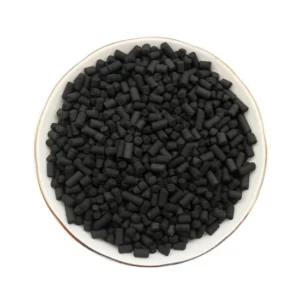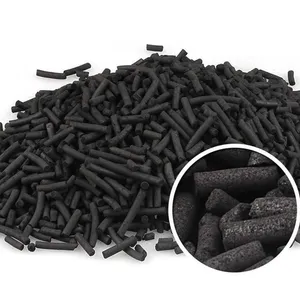
How to make activaed carbon
As we all know, activated carbon plays an important role in the field of water treatment. It can absorb organic matter, heavy metals and other pollutants in water to improve water quality. So how to make activated carbon? Let’s talk about it today.
1. Raw material selection:
In principle, all coal can be processed into activated carbon. However, the quality of products varies significantly depending on coal quality. To better meet market demands and optimize resource utilization, China’s current production primarily uses weakly caking bituminous coal from Datong, Shanxi Province, and Taixi anthracite from Ningxia. Xinjiang bituminous coal is also suitable for activated carbon production. In recent years, with the development of coal seams and economic growth in Xinjiang, more manufacturers have adopted this coal for production. Additionally, some enterprises in Shenmu, Shaanxi Province utilize local bituminous coal, though the resulting activated carbon typically exhibits lower adsorption values, with iodine adsorption levels mainly ranging between 400-700 mg/g.
2. Carbonization and activation process:
“Activated carbon is a carbon adsorbent after carbonization and activation of carbon-containing materials”, according to this definition, there are two essential processes in the production of activated carbon, namely carbonization and activation.
Carbonization stands as a primary thermal treatment in activated carbon manufacturing, with mainstream equipment including fluidized beds, rotary kilns, and vertical carbonization furnaces. The standard temperature for coal-based activated carbon carbonization ranges between 350-600°C. During this process, non-carbon elements like hydrogen and oxygen are primarily decomposed into gases at the high temperatures, effectively removing volatile components and moisture from the raw materials. The released carbon atoms then combine to form ordered crystalline structures known as basic graphite microcrystals, creating initial pore networks that establish the original structural framework of activated carbon. The processed material is termed “carbonized material,” which exhibits limited adsorption capacity—typically showing only about 200 mg/g of iodine adsorption value when tested.
Activation methods are classified into physical activation (also known as gas activation) and chemical activation based on the type of activator used. The physical activation method is commonly employed for coal-based activated carbon, where gases such as steam, flue gas (a mixture of steam, CO2, N2, etc.), CO2, or air are introduced into the carbonized material at temperatures between 800-1000°℃ (flue gas being the most frequently used in industrial practice). The activation process achieves pore formation through three stages: opening previously blocked pores, expanding existing pores, and creating new pores. This is primarily accomplished using specialized activation furnace equipment. Current mainstream models include SLEP furnaces, STK furnaces, rake-type furnaces, and rotary furnaces. In China, SLEP furnaces remain the predominant gas activation system in domestic applications.


3.The finished product stage:
This process involves producing products with varying particle sizes according to application requirements. For granular activated carbon, the main procedures include crushing, sorting, and packaging. Crushing equipment typically employs double-roll crushers, where adjusting the gap between the rollers controls particle size distribution to improve screening efficiency. Screening equipment usually uses vibrating screens to separate crushed materials into three categories: larger, qualified, and smaller particles. In actual production, multiple layers of screens are often added to the vibrating screen to filter products within specific size ranges, with qualified particles being packaged for sale. Industrial applications typically adopt packaging methods such as 500kg/bag and 25kg/bag. Additionally, during production, special-purpose products undergo stone-removing machines and iron-removing machines to reduce ash content. For powdered activated carbon, the primary processes involve grinding and packaging. Most factories now use Raymond mills for grinding, where adjusting the mill’s analyzer produces finished powder carbon with 200-mesh and 325-mesh particle sizes.
4. Deep processing stage:
For products with specific applications, the finished activated carbon undergoes advanced processing including acid washing, alkali washing, and water rinsing. The primary purpose of acid washing is to reduce ash content, prevent secondary pollution during use, and enhance its suitability for food processing and other industrial applications. Additionally, certain industrial processes require activated carbon impregnation agents to achieve optimal adsorption performance.
Other Pre-treatment Stages:
While the processes mentioned above are standard for coal-based activated carbon production, specialized steps are required for block-shaped and cylindrical activated carbon manufacturing. Block-shaped carbon undergoes additional pretreatment stages including coal blending, grinding, kneading, extrusion molding, crushing, and sieving to achieve proper particle size distribution before carbonization. The pretreatment procedures for cylindrical activated carbon mirror those of block-shaped carbon, differing mainly in extrusion methods: block-shaped carbon is compressed into blocks, whereas cylindrical carbon is extruded into cylindrical bars.
In conclusion, there are still many technical details to address in activated carbon production. Different raw materials and carbon types require tailored manufacturing processes. While this article provides a basic overview of production methods and techniques, ongoing advancements in activated carbon research continue to introduce new technologies that demand ongoing attention. We hope this article proves helpful in your journey.
Our company provides high quality and stable products, including reverse osmosis system, sludge dewatering machine, mechanical grille, dosing device, electrical control cabinet, etc., our professionals will provide you with installation, commissioning, operation, and follow-up maintenance services to help you solve problems!
Yixing Shenghe Environmental Protection Co., Ltd.

IPv6 network supported